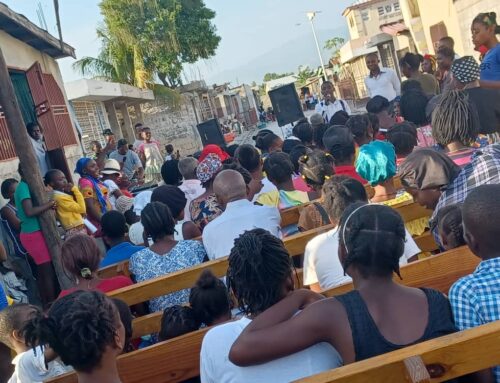Four years after the earthquake, Haiti looks to turn disaster into promise
New Canaan Church Being Planted >
By Jacqueline Charles, Miami Herald
CANAAN, Haiti — The sun-baked cinderblocks in Claude Saint-Elys’ dirt yard are an eroding reminder of the dream: a two-bedroom house with enough room for him, his wife and five surviving children.
“We have rocks and blocks. That’s it,” Saint-Elys, who lost his 5-year-old son in the Jan. 12, 2010 earthquake, said about building his dream home on this barren hillside north of Haiti’s capital.
Across the way, down a dirt road, truck driver Mackenson Chery is building his dream brick by brick. Chery’s spacious home is partly walled-in with newly cemented blocks and covered with shining zinc sheeting.
“We help each other around here,” Chery, 33, said. “It’s us, the mosquitoes and the dust balls.”
An arid land, Canaan — named after the Biblical town — has become a squatters’ paradise of mushrooming construction of makeshift shacks and concrete homes, with quake victims, land speculators and ordinary Haitians seeking opportunities.
Now, as Haiti marks the fourth anniversary Sunday of the tragedy that left more than 300,000 dead and 1.5 million homeless, this haphazardly built community, born out of the disaster, is in the midst of a rebirth. And many are concerned that this rebirth is more a throwback to the country’s history of disorderly construction instead of the planned, quake-resistant communities that were envisioned.
“There is a huge construction dynamic happening there,” said Odnell David, Haitian government housing division director. “We can’t keep it like this, otherwise it will become a massive slum. We have to accompany the people.
“The people, they had a dream. And in their minds, they did not construct a slum, but rather a city.”
While Canaan has almost all of the amenities of a city — churches, schools, football fields, mom and pop shops in a commercial district — it is anything but well-planned.
“When I see Canaan, I see the exact replica of Cité Soleil — a politics of neglect, a large growing cancer,” said Leslie Voltaire, an urban planner who worked on housing issues shortly after the quake. “It’s the image of the reconstruction, but by the people and without any resources.”
And that is a disaster waiting to happen in a country where poor construction and urban planning led to the earthquake’s massive death toll and the collapse of almost 200,000 buildings, say experts.
With the population estimated to be between 54,000 and 250,000 people, Canaan has become symbolic of the failings of Haiti’s post-quake response. Under U.S. pressure to find land for housing, the government of former President René Préval declared the large tract of land for public use, triggering an illegal occupation by Haitians seeking the promised land. But instead of free government housing, they found speculators selling them plots without titles.
Four years later, government officials are still haggling with some of the country’s most economically powerful families to gain title to the land while Haitians continue to stake their claim, marking their parcels with barbwire fencing, wooden frames and unfinished foundations. Gradually, they have transformed the community’s 2,792 acres from a sea of temporary blue tents to permanent housing valued at $100 million, according to government officials, citing an international evaluation.
And while issues still remain with land tenure, the U.S. Agency for International Development recently agreed to assist Haiti with getting “ahead of the curve,” by funding $3 million in technical assistance. The decision, officials say, is part of a new thinking of allowing Haitians to take control of their own development.
“Donors come in here and they sort of do things for Haitians,” said USAID Mission Director John Groarke. “We need to move beyond that, and begin to help Haitians to help themselves.”
Haitian Prime Minister Laurent Lamothe said there has been progress over the last four years, not just from the more than 90 percent drop in people living in camps, but from the feelings of despair that have turned into hope.
“We have a country that’s starting to believe that we can get back on our feet,” he told the Miami Herald.
Still, Lamothe acknowledges that getting people displaced by the disaster into permanent shelter hasn’t been easy.
In September, at the request of the Haitian government, an estimated 54,000 residents of Canaan were removed from the list of people considered internally displaced (IDP).
Gladys Melo-Pinzon, country specialist for Amnesty International, calls the decision troubling. The human rights organization estimates that 45 percent of Haitians still in camps are at risk of being forcefully evicted.
“Without their official status as IDPs, those living in the areas of Canaan,” Melo-Pinzon said, “may not be afforded the oversight and protection needed to abate future violent evictions.”
David said the government has no intention of evicting anyone from Canaan, and is seeking to work around what residents have already built.
Still, 200 families living in a nearby area called Mozayik were evicted last month.
“Canaan is seen in some ways as one of the solutions, and yet there are places in there where people are being evicted,” said Nicole Phillips, a lawyer with the Institute for Justice & Democracy (IJD), a Boston-based human rights advocacy group.
The evictions from Camp Mozayik “flies in the face of the concept that everyone is welcomed there,” she said.
On Monday, in response to the Haitian government and donors touting the overall success of reducing the quake homeless from 1.5 million to 146,573, IJD issued a report highly critical of 16/6, the government’s prized relocation program that provides a one-year rental subsidy to those in camps.
“It was successful in shutting down the camps,” said Phillips, noting that more than half of those tracked had difficulty paying rent after a year. “But in terms of being a solution to the housing problem, it’s not. People are in the same situation. It’s quite frustrating to hear both the Haitian and U.S. government talk about solutions that are not necessarily solutions.”
Like most in Canaan, Dieusel Guerrier arrived in the weeks after the quake. At the time, there were only a few tents, he said.
“Before our arrival, no one saw the value of this land,” he said. “But we accepted the humiliation to come live out here with the mosquitoes and flies to show this is a place where humans can live.”
While Guerrier is defiant in his position that he won’t be evicted, others live in constant fear they could be.
School teacher Evens Chery, 27, said he only recently had the courage to put up wooden frames on the small plot he settled on four years ago after the quake destroyed his Petionville childhood home, and killed his father.
He’s on his 14th tent, an oversized weather-beaten canvas he shared with his family until his wife, three months ago, left with his two young sons, saying she couldn’t live underneath a tent anymore.
“I don’t invite friends over because for me, this is a deplorable way to live,” he said.
Still, he carries himself with a measure of pride, dressing with a tie and shirt every morning to teach second graders Creole Grammar at the nearby school.
“You can’t let people know how you’re living. But this housing situation is my biggest problem,” he said. “I don’t sleep at night. All I do is think.”
Like many, Chery says he’s not waiting on the government to seal his fate — “you can’t,” he said.
“I don’t live for the government; you have to do it for yourself,” Chery said. “You can’t put it in your head that they are going to do something for you.”
For now, the government only has $6 million, which includes USAID’s contribution, to put toward what David hopes will be a pilot program offering water, sanitation, roads and lessons on how to properly build. But perhaps the biggest challenge will be gaining the trust of a population that until now has been fending for itself with no basic services from the government.
“There is no water, there is no electricity” said Jean-Luckner Dupervil, a resident and co-head of the local community in Canaan 2. “When people have needs, they either do it in a bucket and later bury it, or go into the bushes.”
Dupervil said he came to the site shortly after the quake, and paid a nominal fee to occupy his small parcel. These days, he directs an aid group on where to build the houses they have committed to give to the population.
As he speaks, a group of visiting university students from Maine form an assembly line to move construction material along to its final destination.
A look around the area shows a movie house made of wood and zinc; several mom and pop stores, a football field and a school for elementary-age children. Across National Highway 1, which connects the capital to northern Haiti, a brand new International Olympic Committee-donated stadium rises in the shadows.
David, the housing director, acknowledged that turning the area into an organized space won’t be easy, beginning with figuring out who lives there and how many. He was surprised to learn that an aid group was building homes in the community without permission.
“It’s complicated, but not impossible,” he said. “The population is moving faster than the state but everything requires reflection.”
Development experts and urban planners say that Canaan is the logical continuation of Haiti’s overly populated capital.
“The time is now to do something before it becomes completely uncontrollable,” said Sandrine Capelle-Manuel, program coordinator in Haiti for UN Habitat, which is advising the government on the issue. “There is a possibility to make that a real city and not a Cité Soleil in five years.”
Reprint from the Miami Herald





